Dear Aspirants, Our IBPS Guide team is providing new series of Reasoning Questions for LIC AAO Mains 2019 so the aspirants can practice it on a daily basis. These questions are framed by our skilled experts after understanding your needs thoroughly. Aspirants can practice these new series questions daily to familiarize with the exact exam pattern and make your preparation effective.
[WpProQuiz 5684]
Click Here to Take LIC AAO Prelims Mock Test
Click Here for Mains 2019 High-Quality Mocks Exactly on SBI Standard
Click Here to View Reasoning Questions in Hindi
Directions (1-5): Study the following information carefully and answer the question below:
Ten persons G, L, M, B, W, S, P, K, Z and Y are sitting around a circular table facing centre. Each one of them likes different fruits Mango, Papaya, Orange, Kiwi, Apricot, Banana, Pine apple, Apple, Dragon fruit and Avocado. All the above information is not necessarily in the same order.
Three persons sit between Y and the one who likes orange. W is an immediate neighbour of neither the one who likes orange nor Y. L does not like Apple. W does not like orange. The one who likes Banana and the one who likes orange are not immediate neighbours. Y does not like Banana. B is an immediate neighbour of neither W nor Y. The one who likes Apricot sits immediate left of the one who likes Dragon fruit. W neither likes Apricot nor likes Dragon fruit. The one who likes orange and the one who likes Apricot are not immediate neighbours. The one who likes Dragon fruit sits fourth to the left of B. S, who likes Avocado sits immediate right of Z. The one who likes Kiwi sits second to the left of S. Only one person sits between L and the one who likes Kiwi. The one who likes apple sits second to the left of M. The one who likes Banana sits third to the right of W. P and the one who likes Mango are immediate neighbours. L does not like Papaya. G does not like Banana. Y neither likes Pine apple nor Mango.
1) Which of the following person likes Apricot?
a) Y
b) L
c) G
d) K
e) None of these
2) Which of the following person sits fifth to the left of the one who likes Papaya?
a) Second to the left of W
b) Third to the right of the one who likes Mango
c) Second to the right of the one who likes Apricot
d) Immediate left of Z
e) None of these
3) How many persons sit between K and the one who likes Kiwi, when counted from right of K?
a) Four
b) Five
c) Three
d) Two
e) None of these
4) If B is related to Papaya, M is related to Apple, in the same way which of the following is related to Orange?
a) Y
b) L
c) K
d) W
e) None of these
5) Four of the following five are like in a certain way based on the above arrangement. Find the one which does not belongs to the group?
a) G-Dragon fruit
b) Z-Kiwi
c) M-Banana
d) K-Papaya
e) W-Apricot
Directions (6-10): Study the following information carefully and answer the questions given below:
Seven persons K, F, R, S, T, V and M attend the lecture in a week starts from Monday and ends on Sunday. Each one of them are in different age 16, 38, 43, 27, 32, 35 and 21. Consider all the ages are in years. All the above information is not necessarily in the same order.
Two persons attend the lecture between R and the one whose age is 43. The one who is the eldest was born after Thursday but before Sunday. More than three persons attend the lecture between K and S, who is not the oldest. S attends the lecture neither on first nor on last of the week. K is 6 years younger than T. T is 3 years elder than V. The one who is youngest attends the lecture immediately after K. As many persons attend the lecture above M and below F are same. Age difference between S and F is a perfect square of a number. T attends the lecture before F.
6) What is the age difference between sum of K and R and sum of S and T (in years)?
a) 20
b) 18
c) 17
d) 23
e) None of these
7) What number should be added to the total sum of T, F and V to make it as a perfect square?
a) 8
b) 9
c) 10
d) 5
e) None of these
8) If K is related to 35, S is related to 16, in the same way T is related to which of the following?
a) 32
b) 38
c) 21
d) 43
e) None of these
9) How many persons attend the lecture between M and the one whose age is third eldest?
a) 1
b) None
c) 2
d) 3
e) None of these
10) How many persons attend the lecture above V?
a) 3
b) 6
c) 4
d) 5
e) None of these
Answers:
Directions (1-5):
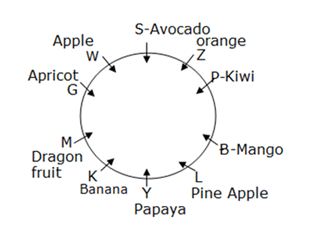
Three persons sit between Y and the one who likes orange. The one who likes Banana sits third to the right of W. W is an immediate neighbour of neither the one who likes orange nor Y. W does not like orange. The one who likes Banana and the one who likes orange are not immediate neighbours. Y does not like Banana.

B is an immediate neighbour of neither W nor Y. The one who likes Dragon fruit sits fourth to the left of B. The one who likes Apricot sits immediate left of the one who likes Dragon fruit. W neither likes Apricot nor likes Dragon fruit. The one who likes orange and the one who likes Apricot are not immediate neighbours.

S, who likes Avocado sits immediate right of Z. The one who likes Kiwi sits second to the left of S.

Only one person sits between L and the one who likes Kiwi. The one who likes apple sits second to the left of M. L does not like Apple. P and the one who likes Mango are immediate neighbours. L does not like Papaya. G does not like Banana. Y neither likes Pine apple nor Mango.

1) Answer: c)
2) Answer: b)
3) Answer: c)
4) Answer: d)
5) Answer: b)
Directions (6-10):
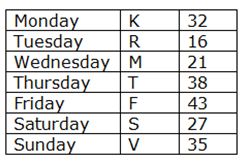
Two persons attend the lecture between R and the one whose age is 43. The one who is the eldest was born after Thursday but before Sunday.
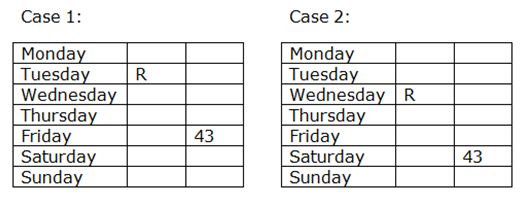
The one who is youngest attends the lecture immediately after K. More than three persons attend the lecture between K and S, who is not the oldest. S attends the lecture neither on first nor on last of the week.
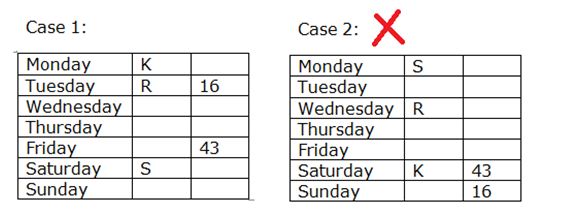
Case 2 will be dropped because S attends the lecture neither on first nor on last of the week.
K is 6 years younger than T. T is 3 years elder than V. As many persons attend the lecture above M and below F are same.
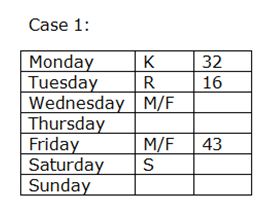
T=38 and V=35
Age difference between S and F is a perfect square of a number. So S should be 27 and F should be 43. So age difference between S and F is 16.
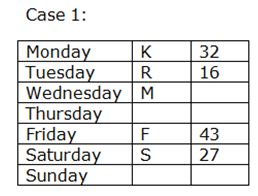
T attends the lecture before F.

6) Answer: c)
7) Answer: d)
8) Answer: b)
9) Answer: d)
10) Answer: b)





